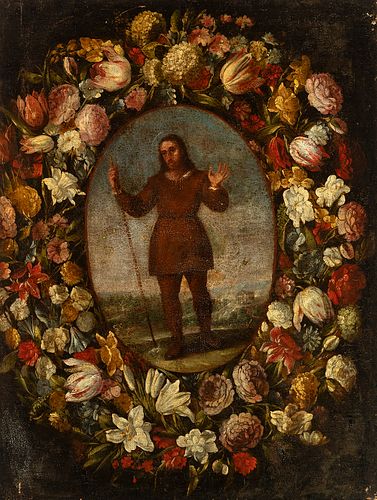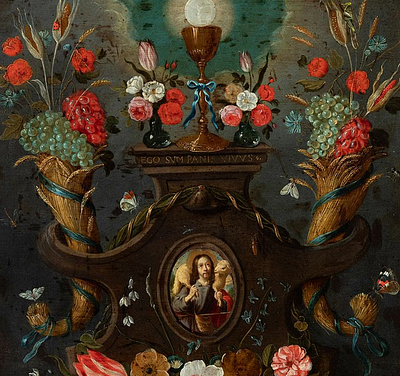Madrid school; first half of the 17th century. "Orla con flores con San Isidro". Oil on canvas. Relining.
Lot 40
About Seller
Setdart Auction House
Carrer Aragó 346
Barcelona
Spain
Setdart Subastas was born in 2004 and is currently the first online art auction in Spain with solidity, prestige and reliability guaranteed by our more than 60,000 users. Setdart has a young, dynamic and enterprising team ready to successfully manage the purchase and sale of art works through custom...Read more
Estimate:
EUR€2,000 - EUR€2,500
$2,105.26 - $2,631.58
Absentee vs Live bid
Two ways to bid:
- Leave a max absentee bid and the platform will bid on your behalf up to your maximum bid during the live auction.
- Bid live during the auction and your bids will be submitted real-time to the auctioneer.
Bid Increments
| Price | Bid Increment |
|---|---|
| EUR€0 | EUR€10 |
| EUR€200 | EUR€25 |
| EUR€500 | EUR€50 |
| EUR€1,000 | EUR€100 |
| EUR€3,000 | EUR€200 |
| EUR€5,000 | EUR€500 |
| EUR€10,000 | EUR€1,000 |
| EUR€20,000 | EUR€2,000 |
| EUR€50,000 | EUR€5,000 |
About Auction
By Setdart Auction House
Sep 21, 2021
Set Reminder
2021-09-21 10:00:00
2021-09-21 10:00:00
America/New_York
Bidsquare
Bidsquare : 21st September - ARAS JÁUREGUI Private Collection - Old Masters, 19th & 20th Century
https://www.bidsquare.com/auctions/setdart-auction-house/21st-september---aras-j-uregui-private-collection---old-masters-19th-20th-century-7429
Setdart Auction House sofia@setdart.com
Setdart Auction House sofia@setdart.com
- Lot Description
Madrid school; first half of the 17th century. "Orla con flores con San Isidro". Oil on canvas. Relining. It presents imperfections, faults and repainting. Measurements: 106,5 x 81 cm. In this devotional image, the author follows one of the most popular fashions in the XVII century, of Flemish tradition, and that quickly spread to other schools. This fashion consisted of combining the genre of nature, in the manner of a garland, as a framing and enhancing element of a central theme of a religious nature. This piece is notable for the great profusion of flowers, with a wide variety of tones and species, including tulips, roses, carnations, daffodils and so on. In the case of the religious scene, it is likely to be a representation of Saint Isidore. Saint Isidro Labrador (Madrid, 1080-1172), married to the saint María de la Cabeza, was beatified by Paul V in 1619, and canonised in 1622 by Gregory XV. He was declared patron saint of Spanish farmers by John XXIII in 1960. Several miracles are attributed to this saint, among the most famous being that of the well in which, thanks to his prayer, the waters rose so that his son, who had fallen in, could be rescued. Another is the one in which the angels help the saint to plough a field, thus allowing him to stop and pray in all the parishes he passed through on his way to work. His iconographic representation is directly related to his work as a farmer, his most frequent symbols being the tools of the field, such as the hoe or the spade. He is also often depicted with a rosary, grilles or ears of corn. The Madrid school emerged around the court of Philip IV and later Charles II, and developed throughout the 17th century. Analysts of this school have insisted on considering its development as a result of the binding power of the court; what is truly decisive is not the place of birth of the different artists, but the fact that they were educated and worked around and for a nobiliary and religious clientele based next to the royals. This allowed and encouraged a stylistic unity, even though there were the logical divergences due to the personalities of the members. The origins of the Madrid school are linked to the accession to the throne of Philip IV, a monarch who made Madrid an artistic centre for the first time. This was an awakening of the nationalist conscience as it allowed a liberation from the previous Italianate moulds and a leap from the last echoes of Mannerism to Tenebrism. This was the first step taken by the school, which gradually progressed towards a more autochthonous Baroque language linked to the political, religious and cultural conceptions of the monarchy.
- Shipping Info
-
In-house shipping available. Please inquire at admin@setdart.com.
-
- Buyer's Premium



 EUR
EUR CAD
CAD AUD
AUD GBP
GBP MXN
MXN HKD
HKD CNY
CNY MYR
MYR SEK
SEK SGD
SGD CHF
CHF THB
THB
















